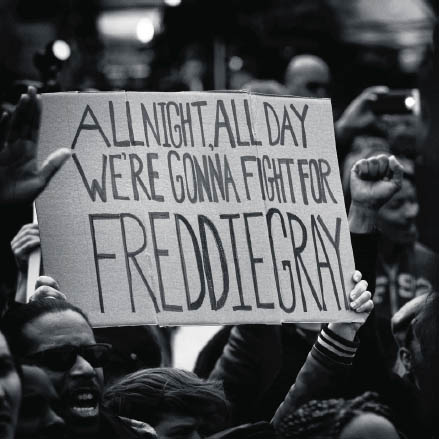


SHEILA PREE BRIGHT IS A PHOTOGRAPHER
AND ACTIVIST-ARTIST
who continues to express herself through the visual experience. She makes engaging photographs and creates provocative installations while creating a series of critical images of what it means to be an American. For Bright, creativity is part of a collaborative process. She contextualizes the voices of young protesters by weaving their words and faces into her portraits. She brings the same passion to her documentation of today’s social protest movement from Atlanta to Baltimore to Ferguson to Washington, DC, as did her predecessors who made photographs in the 1960s civil rights protests for equal rights. Whether it’s the right to free speech or the desire to have a sound education or the right to fair housing opportunities, Bright champions the right of all Americans to a full participation in the American democratic process. It is encouraging to see Bright’s contemporary photographs connect to these historic events, hence the title of her series #1960Now.
Bright herself was not yet born when young civil rights activists took to the streets, boarded buses, and entered into spaces that would possibly harm them and/or end their lives. Always interested in documenting moments and telling visual stories through her projects, she recently wrote, “As I observe the state of our country, I feel art can assist in creating cultural and neighborhood awareness for social good.” Bright frames the ideas of the Black Lives Matter movement as it is reflected in the faces of the people who live in and those who travel to cities such Ferguson and Baltimore to support the local activists—from young women to young men, to mothers and fathers who walk the streets carrying the message on banners that “Black Lives Matter.” The powerful moments depicted in the photographs portray Bright’s empathy and support as both participant and observer. The beautifully rendered images are stark and direct. With her camera, she homes in on the faces, the T-shirts, and the handwritten placards—“All night, all day, we’re gonna fight for Freddie Gray”; “#StolenDreams,” with the high school portrait of Michael Brown; “We love our people and we will be here until justice is served.” With the photographer’s commitment and support of the movement, these words and images equally become portraits of the participants. Bright cares deeply about the young girls and boys, men and women, Black and White, Asian and Latina, Christian and Muslim, who are committed to human rights and civil rights for American citizens. In pondering the past, Bright photographed a banner (#It’sBiggerthanyou ReclaimMLK) that connects to the memory of the martyred civil rights leader Dr. Martin Luther King Jr. following his dream to obtain equal rights for Black Americans. Bright honors the aesthetic of movement imagery, digitally creating black-and-white photographs that memorialize the past and present.

Chair of the Department of Photography & Imaging at the Tisch School of the Arts at New York University

The lyrics to vocalist and songwriter Gregory Porter’s hit title “1960 What?” inspired Bright’s initial project, 1960Who, which evolved into #1960Now.
#1960Now focuses on policing in Black neighborhoods and questions the use of extreme force resulting in the deaths of young Black men such as Trayvon Martin, Freddie Gray, and Michael Brown, among others. Bright’s work as a photographer and as a woman is significant in making visible the voices and images of women who are prominent in her photographs. Rarely are the voices of mothers and women highlighted in American social protest imagery. There is a powerful presence of women in the Black Lives Matter movement. As cultural worker, artist, and cocreator of the Black Lives Matter Global Network, Alicia Garza writes in her essay A Herstory of the #BlackLivesMatter Movement: “I created #BlackLivesMatter with Patrisse Cullors and Opal Tometi, two of my sisters, as a call to action for Black people after 17-year-old Trayvon Martin was posthumously placed on trial for his own murder and the killer, George Zimmerman, was not held accountable for the crime he committed. It was a response to the anti-Black racism that permeates our society and also, unfortunately, our movements. Black Lives Matter is an ideological and political intervention in a world where Black lives are systematically and intentionally targeted for demise. It is an affirmation of Black folk’s contributions to this society, our humanity, and our resilience in the face of deadly oppression.”
As mentioned previously, memory is central to Bright’s social practice in making artful documentary images. These images powerfully expose the complexities in photographing social movements. For example, the American flag is an iconic object in Bright’s work. Throughout #1960Now the flag functions as a symbol, a banner for marginalized individuals claiming an identity in the fabric of America. This is critical today as it connects to the #1960Now project, which includes portraits of young people in Black Lives Matter movement groups throughout the country. Bright defines the project as “generations of young people who have committed their lives for social good.”

2015, protest, “All Night, All Day, We’re Gonna Fight for Freddie Gray,” Baltimore, MD